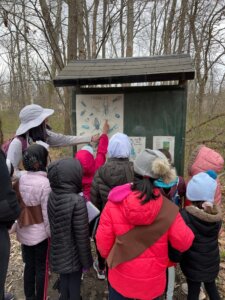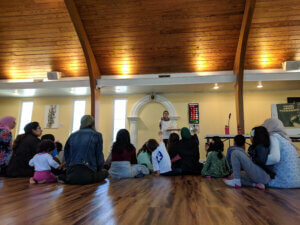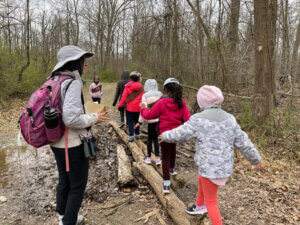How did you get interested in nature?
This is my favorite point of conversation! The story goes back to my childhood. I grew up in central Alabama, and I look like a typical White American, so people often ask, “Are you a convert to Islam?” No, I was actually raised Muslim. My father is Turkish, and my mother is American, and my faith has always been incredibly important to me.
In the early 1990s, my religious identity became more prominent and more of an issue, and I did experience quite a bit of prejudice about being Muslim. However, being a unique faith minority in the U.S., having a mixed background, and half of my relatives being Christian, I never saw that difference in faith as making me better than anybody else. I never saw myself as right and everybody else wrong. I worked through it and tried to point out the similarities between my faith and others’; whether they were Christian or Jewish or agnostic, I always felt that there was something that we could connect with in terms of deep spiritual values. And that formed my understanding of human nature, human relations, and also my faith. If my faith teaches that we all come from the same source, then in a sense, we’re all brothers and sisters – why would that divide us? It should bring us together, and fortunately I’ve held onto that childhood ideal.
Growing up in Alabama, I never went to a mosque, I never attended community prayers or what (even in the Muslim world) we call Sunday School. Even so, my faith stayed important to me. My family moved to the Washington, DC area, and then I started college, and I started interacting with other Muslims. I was a little shy at first, thinking “Maybe I don’t know my faith well enough,” but they accepted me. Now, I feel that they are my community and that I have an important role to play.
When I became a mother, I looked back at something that I had completely taken for granted, and that was the role my natural environment played in my faith when I was a child. Although I didn’t go to a mosque, I would go outside and explore the woods by myself, and it was a deeply personal spiritual experience. My mother volunteered at a local arboretum, so I learned a lot about plants. I looked at trees, I watched the water, I made friends with the ducks, I saw the rocks. Everything about nature fascinated me, and it was all so beautiful and so perfect, and I felt so good when I was out in nature that I automatically associated it with what I called God. It was my spiritual connection, my house of worship, because the proof was everywhere around me, and I felt closer to my Creator when I was surrounded by natural creation.
I was happy that my child would be growing up in a more diverse area, and she’d interact with people of many different faith perspectives, as well as different perspectives within her faith. And, I wanted her faith to be her faith – I didn’t want her to just take on everything she learned in [Muslim] Sunday school. More than anything else, I wanted her to have a direct connection with what she sees as her Creator.
So, even when I was still carrying my daughter inside of me, I took her on nature hikes for as long as I could manage, and then as soon as she was born, I was carrying her on my back and then pushing a stroller. I realized what an important role nature had played in my spiritual development, and so I wanted to expose her to as much nature as possible. I also became concerned about everything she was ingesting; I started to think about organic food and pollution. I needed to make sure she was safe physically, mentally, and spiritually.
Up until then, I hadn’t pursued a career in anything dealing with the environment; my education was in political science, and then I had transitioned to being an editor. And after taking a break to be a stay-at-home mom, the first job I took was an editing job with the Virginia Chapter of Sierra Club.
At the same time, I had many friends who (although they were born and raised in the U.S.) strongly felt the influence of their parents’ international urban cultures, and they had fears of going out in the woods. Hearing that I was taking my daughter out into nature, they started telling me that I should take their kids out with me too, so that their kids wouldn’t be afraid of nature. And I realized along the way that nature is my passion, getting kids into nature and teaching them to love it and see its beauty is my passion. And the next job I took was as the Executive Director of Green Muslims.
Everything about nature fascinated me, and it was all so beautiful and so perfect, and I felt so good when I was out in nature that I automatically associated it with what I called God.
What does Green Muslims do?
Green Muslims wants to connect Muslims more deeply to God through nature, and also to help more Muslims realize that we should actively protect nature. Islam teaches that humans are the “khalifa” of the earth. One of the most common translations for “khalifa” now is “steward.” So we point out that environmental stewardship is actually a basic tenet of our faith, a God-given responsibility because Islam teaches us that we are the stewards of the earth. And we want to be a stepping stone to that.
Green Muslims is not a huge organization, but we’ve been around a while, so we have an established voice to share. We work primarily as volunteers in addition to other jobs; my work as Executive Director started as a volunteer position, though now we do have some part-time paid employees. The last couple of years have seen a major increase in interest in having a Muslim voice in green discussions, so we’ve been invited to speak on a lot of occasions, and then within the greater American Muslim community, there’s a bigger environmental movement as well.
We have a number of public programs for families and children. We work a lot with youth groups or family-based parts of local Islamic centers. We are also trying to become a bridge between the Muslim community and larger organizations that have more information about specific actions to take as a community, like trying to get solar panels for mosques or finding ways to conserve water – ways to change our physical impact on the earth.
We point out that environmental stewardship is actually a basic tenet of our faith, a God-given responsibility because Islam teaches us that we are the stewards of the earth.
What have you been most excited about as the Executive Director of Green Muslims?

Sevim talking to a Brownie troop about insects they might find on their hike. (April 2022, Runnymede Park, Herndon, VA)
My biggest passion in my work with Green Muslims has been a program called Our Deen is Green – “deen” being the Arabic word for faith or religion. It gets kids into natural settings so that they can experience nature and its spiritual aspects, and also has lessons about how we need to care for the environment. Green Muslims was already doing this program when I joined them, which was fantastic, because it was exactly what I wanted to do anyway.
As I have become more well-known within the local Muslim community, and after becoming a master naturalist in Fairfax County, VA, there’s been a big push for us to offer more and different classes. Additionally, with COVID, there’ve been more people paying attention to nature and to getting outdoors, which is giving me the opportunity to not only teach about what’s out there and how we impact it, but also why we as Muslims should connect with it and care about it. We’re growing a lot right now and getting more funding for more programs, so I’m very excited for the future.
What does it mean to be a master naturalist?
I didn’t know that you could teach about what’s in our natural environment without a formal life science educational background. The Master Naturalist program is a volunteer program that provides relatively inexpensive training in the basics of how our local ecosystems work. It is an intense, short-term training where you learn about your local environment — the plants, the animals, the rocks – and how everything is working together or if it’s not working well. You absorb a lot of information really fast and then you share it with others, and the more experience you get sharing it with others, the more you learn as well. And you need to get a certain number of volunteer hours and continuing education hours to remain a certified master naturalist.
There were a variety of different people in my training, whether retirees, people who wanted to do it as a hobby, to volunteer, or career changers like me. Some people specialize in things like native plants, amphibians and reptiles, or birds. I’m a generalist because I’m passionate about everything. I really enjoy taking kids outside and teaching them about what’s growing and living around us, and our local parks really depend on volunteer work. The master naturalists have a lot to do around here!
How do people get involved with Green Muslims? Do you partner with other organizations too?

Sevim speaking to families at McLean Islamic Center about actions they can take to help the environment.
For individuals, mostly they participate in our activities. Some reach out to me personally and tell me they’re interested in getting involved – I’ve even found staff and board members that way. When we get invitations to partner with other organizations, it’s usually an email saying, “Hey, we heard about you,” or “We saw your website.” Individuals from local Islamic Centers often reach out to us to provide presentations or partner on activities.
I’ve found that within the American Muslim community, we don’t like to step on each other’s feet too much, so when one leader starts something, that’s theirs. We’re all struggling with the challenges of being a minority community, and recent years have also seen a lot of anti-Muslim sentiment that we’ve had to deal with. So, I’m not pushy with other organizations, and community leaders don’t usually reach out to us either, but community members interested in providing environmental education to the community do.
When those partnerships with other organizations do occur, it’s not usually with the director of the organization or the Imam. It’s with the volunteers who lead specific programs, the head of their green team, or the head of their Girl Scouts or youth education programs. Those are the people who reach out to us for partnerships, and I think that works well.
You mention children a lot – why are they a focus?
The biggest influence we’re going to have is not with the leaders, it’s with the youth. They’re our hope. They are growing up concerned about the environment. The elders in our community have had to deal with so many other issues for so long that the environment is not at the top of their priority list. Secular environmental organizations are always asking, “How do we reach out to minorities? Why are they not involved?” Well, there’s just so much on our plates right now. You have to have some degree of comfort and freedom to be able to look at the bigger picture, and that’s why there sometimes seems to be a lack of diversity; because in a lot of minority communities, even if it’s not an issue of economics, they’ve got a lot of other urgent stuff to deal with. I do see greater interest growing, but it starts with the children and those who work with the children, and it grows from there.
Secular environmental organizations are always asking…”Why are [minorities] not involved?” …You have to have some degree of comfort and freedom to be able to look at the bigger picture….in a lot of minority communities…they’ve got a lot of other urgent stuff to deal with.
Is your approach to engaging with faith communities different from when you engage with a more general audience?
No major difference, and in many ways it’s similar to when I was much younger and pointing out similarities. It’s true that each event is different, and I do spend a lot of time considering my approach. Sometimes we have interfaith events, where we want faith to be a key part of the presentation, but not just the Islamic perspective, so we look for similarities between different faith perspectives. And with my more secular programs, I’ve started chatting with parents and saying, “I personally like to bring a more spiritual aspect into it. How do you feel about that?” And generally, they’re fine with it.
Spirituality is the key, and spirituality can mean different things to different people. It doesn’t have to mean religion; it can be as simple as something deeper inside you than what we see around us. I think that’s the key for connecting people of different faith perspectives, or within our own faith perspective, or even those who are not people of faith. Even for Muslim families who are okay with religion being discussed, I start with a very basic spiritual aspect about feeling something and connecting with nature through that feeling. (And for those Muslim families, then I can talk about the 99 Names of God as described in Islam, how the signs of those names exist throughout the natural world, and how we have religious responsibilities to the Earth.) So when you start with that basic spirituality, the similarities between people of different perspectives are pretty strong, and that’s what you can work with. It can be challenging, because you don’t want to step on anybody’s feet, but that’s where I begin. Start talking with people, find something that you can connect with, and work from there — that general understanding that we have something in common.
Start talking with people, find something that you can connect with, and work from there — that general understanding that we have something in common.
What suggestions do you have for scientists or science communicators who want to do more engagement with faith communities?
Don’t email the director of an Islamic center or an imam, saying, “I want to give this talk.” Instead, connect with individuals, starting within your own communities. Whether friends or colleagues, just chat and get them interested. Then they can pull you into their other communities little by little, and you can come in as a friend instead of as an authority. Developing those personal connections is key as a first step to help minimize any discomfort and distrust the community may feel about you. Then, just having informal discussions that intrigue people, and then you may get invited to come and speak about something. A group can be taken aback when you suddenly come in and start telling them what to do, so personal connections are really important.

Sevim leading a Brownie troop on an educational nature hike for a nature badge. (April 2022, Runnymede Park, Herndon, VA)
Also, if the topic can be connected to faith or any other important issue in that community, that helps as well. What I’m finding right now, especially amongst the generation that now has younger children, is that the environment is a major concern. Even if it’s not in the way that I think about it, like, ” I want my daughter to have the spiritual connection with nature because that’s one way of connecting with God,” they may think, “I want my child to be healthy and safe,” and that’s an important issue.
I understand how it can be intimidating, especially when you don’t want to offend anyone, but wanting to avoid saying the wrong thing can freeze you sometimes, so you have to be ready to take some risks. When it’s a one-on-one conversation, it can be easier to apologize or say, “I didn’t mean it that way,” or, “I’m sorry, I’m not sure the right way to say this.”
And I’m not just dictating this to others; it’s something I do myself when talking about some issues that are still relatively new to me, like race and privilege. I don’t want to offend anyone, but I can say some things that may seem offensive when I talk about how we’re all the same and all equal. I wouldn’t be comfortable speaking at a group level that way, but I do want to have these personal conversations and explain where I’m coming from. How I’m only now realizing that it was my privilege that allowed me to have certain perspectives, and how I want to get beyond that privilege. And you can have those conversations at a personal level. Individual people usually aren’t offended when you’re trying to learn about them.





